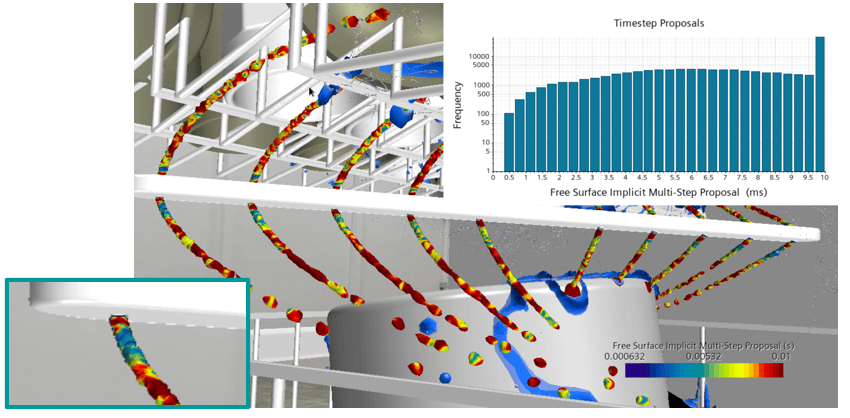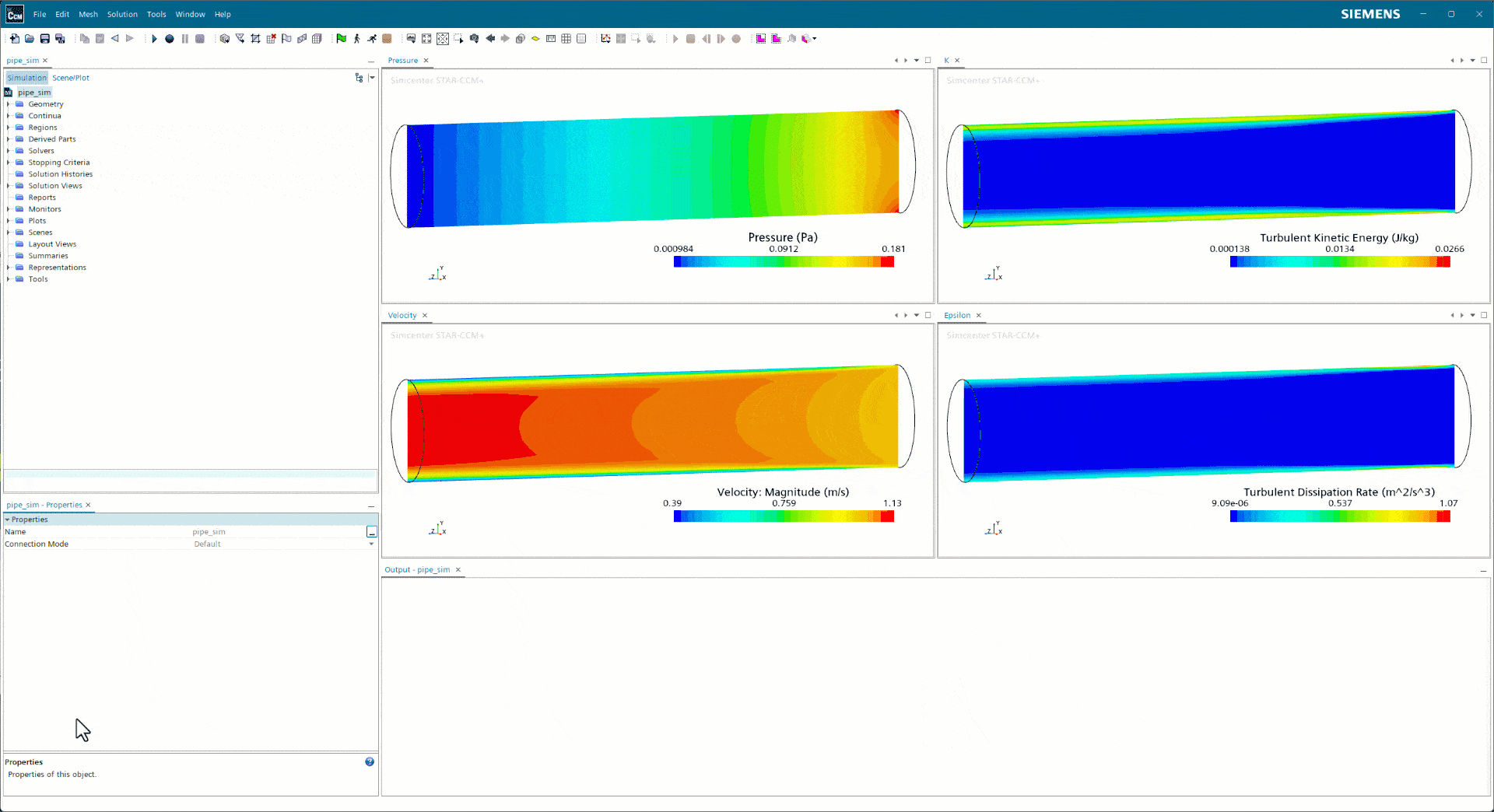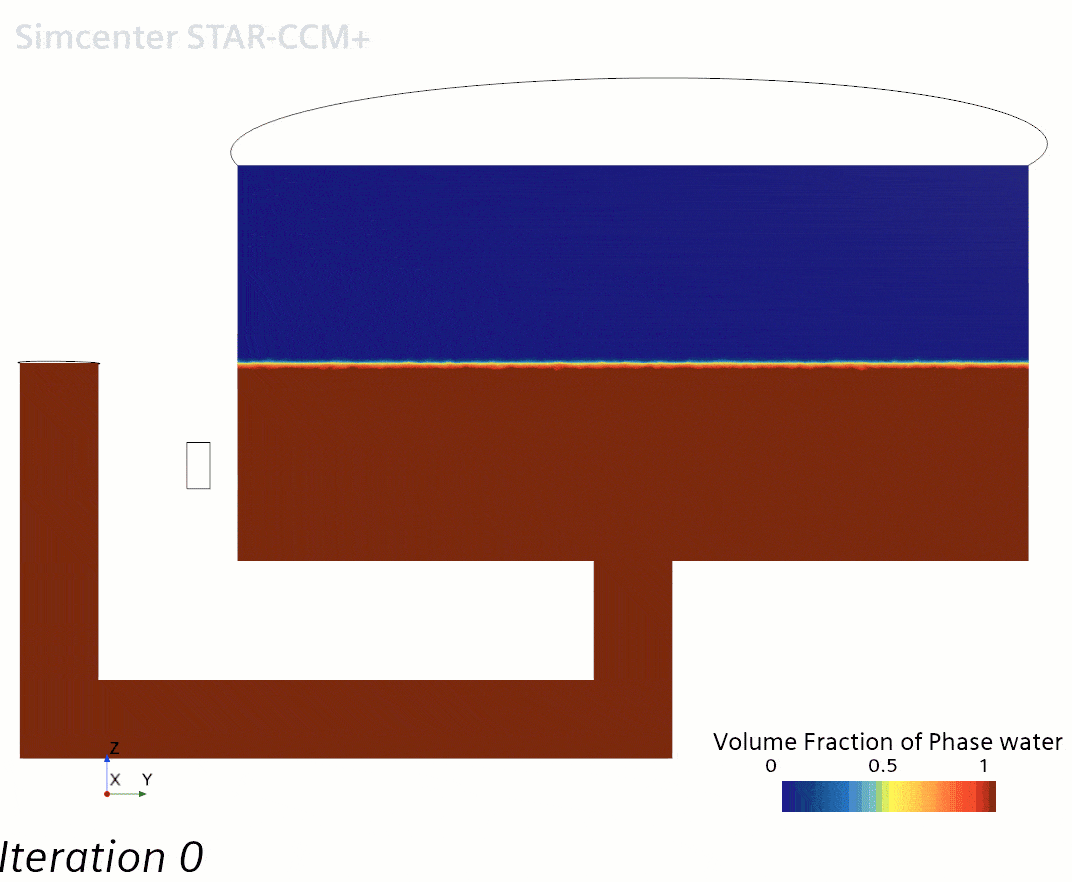Once again, in proximity to the release of the new Simcenter STAR-CCM+ version, we will venture into the news relating to multiphase simulations. Simcenter STAR-CCM+ 2310 was released this Wednesday and contains several exciting news in the multiphase department. Let’s jump right into it. We will start with Eulerian type model news and then move over to the Lagrangian type model news.
Implicit multi-Step for EMP – Large scale interface
Over the last releases the implicit multi-step capabilities have been rolled out for the different model types that work with capturing a large-scale interface. First was the VOF model back in version 2022.1 (Simcenter STAR-CCM+ version 2022.1 news part 1 – Multiphase – VOLUPE Software) to receive the implicit multi-step option. After that it was the MMP-LSI model that received it in version 2302 (Simcenter STAR-CCM+ 2302 multiphase news – VOLUPE Software). This sort of closes the loop, the capability for implicit multi-stepping is now fully exposed in all classical finite volume interface tracking methods. The implicit multi-stepping method will allow you to set the number of temporal sub cycles to be done in a global timestep. In other words, you can set how many times the VOF solver solves for the interface within the global timestep. The general advantage here is that this feature allows you to reduce the simulation time for a given level of accuracy or increase the accuracy for a given level of runtime. The example below comes from the nuclear industry where cooling water is introduced leading to a counter current of displaced gas. Speed-up is shown with increasing number of sub-steps together with the flow field at the end of the simulation.

Interface turbulence Damping (ITD) for EMP – Large Scale Interface
With the expansion of usefulness for the EMP-LSI framework additional effort has been put into accuracy and robustness for the Wall Type treatment by an updated algorithm for determining interface cells associated with wall distance. In reality turbulence should see an interface, like a wall to each phase, and this is what is done with interface turbulence dampening. Simcenter STAR-CCM+ provides two methods for this, “Egorov” and “Wall Type” dampening. It is the Wall type dampening that has been improved to yield more robust and accurate results.
Conservative mapping for VOF for arbitrary remeshing events
This is a new method that performs a volume preserving correction step after mapping onto a new mesh. It ensures conservation of volume fraction if VOF simulations involving periodic remeshing events. Prior to this, the mapping of a flowfield into a new mesh could introduce small errors leading to imbalance in VOF cases. This is no longer the case. This is a useful feature in cases where FSI-calculations are performed since they often require remeshing. The example below shows the development of a first order wave with multiple remeshing events, where the left plot shows that the mass imbalance is kept at zero throughout the remeshing events.
Wall bound droplets (LMP)
This is an exciting new feature for applications where water management simulations are made, such as simulating rain droplets on a windshield or on a sensor. A new type of Wall-bound droplet has been introduced as a new Lagrangian phase type, and this droplet lives in the shell region. This means they are solved for in the same quasi-2D region as the fluid film. This can be beneficial when it comes to speed. The new model of Spherical Cap Particles improves the accuracy of drag and heat transfer calculations. A 2-way coupling with the shell region is added together with a 2-way coupling with the volume regions. This means that the wall-bound droplets can be absorbed into the fluid film by passing mass, momentum, and energy to the film. Additionally, a new model that accounts for the frictional effect of surface tension is provided, that uses the Contact angle hysteresis concept.
Composite collision modeling for droplets
In Simcenter STAR-CCM+, Lagrangian particles/parcels are generally points in space (unless you have DEM-particles). This means that they have no actual volume in the computational domain when it comes to individual parcels. They have scalar fields of velocity, temperature, diameter and so on – but in the simulation they do not explicitly interact. They can overlap essentially. For problems involving droplets colliding there are available models, one being the NTC model (No time counter). That will look at several properties of the droplets and decide numerically if two particles are bound to collide, and from the input it will calculate the resulting effect of two colliding droplet, whether they are combined or end up as separate droplets still. The resulting velocities of the droplets will also be calculated. Previously we had the Ashgritz and O’Rourke map to describe the outcome of the collision. We now have the capability to impact the lines of those maps as a user, and can disable them to eliminate specific outcomes. Typical applications for this include spray drying in chemical and food industries.
Cohesion model for non-spherical DEM-particles
The inclusion of cohesion modeling for non-spherical particles allows for improved accuracy of simulations in agriculture, mining, construction, chemical processing and food industries.
Post-processing and filtering for adaptive timestep providers
The adaptive timestep providers help us filter out unnecessary refinement and set our timestep based on flow features we wish to resolve. In Simcenter STAR-CCM+ 2310 additional post processing has been added to give deeper insight into the adaptive timestep proposals. Essentially, we can now visually determine if the timescales are coming from flow features of interest or from less important areas. The example below shows dishwasher and the field function selected is the “Free surface Implicit Multi-Step” provider. It shows that the smallest timescales are coming from the first part of the jet telling us that further increase of the timestep will from a higher cut off percentage will negatively affect the results.

Aside from these news and updates there are several new features not relating to multiphase specifically. There is a Fiala thermoregulation model for cabin comfort, a huge update (and a separate model) compared to the old one. A first parallelization of the wrapper pipeline has been implemented with potential time to save. Stages is a new automation tool that allows you to have multiple physics setup in a simulation. And interface reactions have been added to the Mixture multiphase model (MMP).
Hopefully there are several features presented in this blog post that will help you in your simulations!
Author

Robin Victor
+46731473121
support@volupe.com

